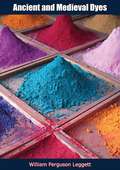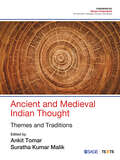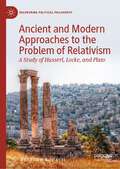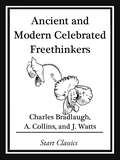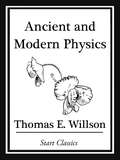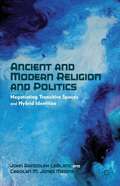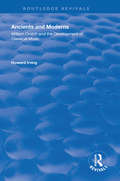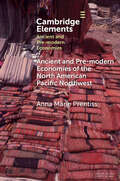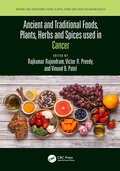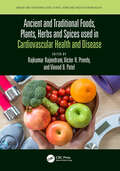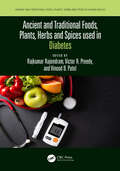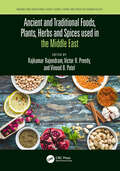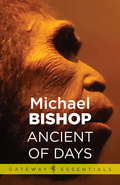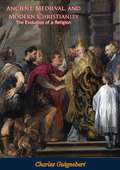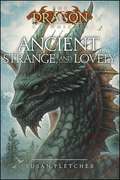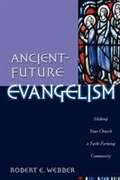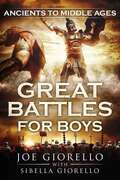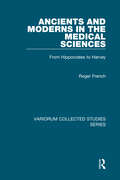- Table View
- List View
Ancient and Medieval Dyes
by William Ferguson LeggettWilliam F. Leggett’s classic text, Ancient and Medieval Dyes, is an informative and easy-to-read introduction to the most common animal and vegetable dyes used before the introduction of synthetic chemical dyes.“Trade in dyestuffs began as soon as the sources of one district were recognized as superior to those used in another district, and, ultimately, this led to the elimination of many of the anciently used dyestuffs, so that of the many hundreds of original primitive dyes only a few survived to ancient and medieval times. The most important of these, divided into vegetable, animal, and mineral groups, are discussed in this book.”—Introduction
Ancient and Medieval Indian Thought: Themes and Traditions
by Ankit Tomar and Suratha Kumar MalikThis textbook offers a lucid and comprehensive account of pre-modern Indian thought and traditions. The book will serve as a helpful reference for undergraduate and post-graduate students of Political Science, Sociology, History and Social Work.This book can also be useful for UGC NET and Civil Service Aspirants It aims to unravel the ideas and thoughts of ancient and medieval thinkers and various intellectual traditions of the Indian sub-continent. The book departs from the conventional approach and carries a context-driven conceptualization of major strands of pre-modern Indian thought. Further, it provides a roadmap to orient the students to the main themes and traditions of Indian socio-political thought. Ancient and Medieval Indian Thought will help the reader to understand the basic concepts of Indian political thought and develop a critical understanding of the major themes and issues such as community, state, kingship, culture and religion as perceived by different thinkers. This multi-authored volume has been designed as a core and invaluable resource for the students, researchers and teachers of political science, sociology and history, and will also be useful for the scholars of other sub-fields of social sciences. Key Features: • Concise and well-balanced coverage of thoughts, ideas and traditions from multi-disciplinary perspective • Extensive summary and glossary terms at the end of each chapter to help the readers recapitulate better • Thought-provoking review questions and suggestions for further reading to enrich the teaching-learning experience
Ancient and Medieval World: From Evolution of Humans to the Crisis of Feudalism
by Rakesh KumarA student-friendly textbook covering the fundamentals of social formations and cultural patterns of the ancient and medieval world. Ancient and Medieval World provides an accessible overview of the period ranging from the evolution of human beings to the end of the Middle Ages in Europe. The book intricately weaves in the research findings of the last decade, which brought about new dimensions on social, economic, political, religious and several other themes of the ancient and medieval world. It presents a comprehensive and well-balanced assessment of the various developments, discoveries and debates in human history that paved the way for the modern world. The use of various maps, images, tables and other robust pedagogical features will motivate readers to read more and help them to connect better with the topic. This book is an ideal companion for students of history, UGC NET and UPSC aspirants as well as general readers. Key Features: • Closely integrates recent research and studies on the subject that have appeared over the last decade. • Introduction of topics and themes such as Nomadic Groups in Central and West Asia and Religion and Culture in Medieval Europe along with new sub-themes. • Provides maps, images, keywords, review questions and extensive bibliography for clearer understanding of themes and issues. • Extensive summary at the end of each chapter to help the reader recapitulate better.
Ancient and Medieval Worlds
by Helen Howe Robert T. HoweAncient and Medieval Worlds takes the reader through life, religion, art and politics during medieval times.
Ancient and Modern Approaches to the Problem of Relativism: A Study of Husserl, Locke, and Plato (Recovering Political Philosophy)
by Matthew K. DavisRelativism, or the claim that it is possible that the appearances and opinions of each of us are correct for each of us, and hence that any view is as true as any other, has remained a continuing problem for philosophy and science for 2,500 years. Today, because of the widespread acceptance of relativism, the problem is greater than ever before. This book argues that Plato in fact solved this problem. In the first two chapters, by means of a study of Husserl and Locke, Davis shows that it is possible to return to and take seriously Plato’s treatment of this problem. The third chapter presents Plato’s solution to it. This book is distinctive in that it shows that a problem that has been thought to be present throughout the history of Western thought was in fact solved by Plato, and in that it shows that we can, beginning from our contemporary situation, return to Plato’s solution.
Ancient and Modern Celebrated Freethinkers
by Charles Bradlaugh J. WattsA fascinating exploration of various freethinkers throughout history, including Thomas Hobbes, Shelley, Hume, Voltaire, Paine, Epicurus, Spinoza, Blount, Toland, and many more.
Ancient and Modern Democracy
by Wilfried NippelAncient and Modern Democracy is a comprehensive account of Athenian democracy as a subject of criticism, admiration and scholarly debate for 2,500 years, covering the features of Athenian democracy, its importance for the English, American and French revolutions and for the debates on democracy and political liberty from the nineteenth century to the present. Discussions were always in the context of contemporary constitutional problems. Time and again they made a connection with a long-established tradition, involving both dialogue with ancient sources and with earlier phases of the reception of Antiquity. They refer either to a common cultural legacy or to specific national traditions; they often involve a mixture of political and scholarly arguments. This book elucidates the complexity of considering and constructing systems of popular self-rule.
Ancient and Modern Physics
by Thomas E. WillsonExcerpt: ...But there are other problems to be explained, problems of life and mind, and the same knowledge you have explains them as well as the others, if you simply avail yourself of it. That you do not consider the atom as four-fold instead of two-fold is your own fault. I have not told you anything you did not already know. I have only asked you to apply your present knowledge of physics to these problems of life and mind, and apply your reasoning powers. "The chording vibration in an atom of matter of "The two planes produces Force, or phenomena "The three planes produces Life-the silver chord "The four planes produces Mind-the golden chord. "You say there is no gulf between the prakritic and etheric worlds; that it is one continuous world; and all its phenomena are by continuity and not impact. That is true, but it is not the whole truth. "There is no gulf to cross between the prakritic and etheric worlds; none to cross between that and the manasic. The four worlds are one great world, continuous, interchangeable. Through the four as well as through the two, there is continuity and not impact. Whether it is an atom or a world, the four are there. Nothing, no combination of atoms, no matter of any kind, however small or large, can exist in this prakritic world unless it has the four elements, which from time immemorial our philosophers have called Earth, Water, Fire, Air, meaning the four globes or forms of matter in the universe. We do not have to leave the earth to live in the etheric globe. It is here. Nor do we have to go millions of miles to reach the pranic globe. It is here. The problems of light and heat are no easier than the problems of birth and death. The pranic globe is within us; within everything. So is the manasic. "It is here on these higher planes that the chances for worthy study are greatest. At least we think so, though you may not. We live on the manasic-pranic-etheric globe on precisely the same terms that we live on this of...
Ancient and Modern Religion and Politics
by John Randolph Leblanc Carolyn M. Jones MedineThis book brings a variety of voices into conversation about the issues of identity, community, tension and violence, and peace in the West: from Sophocles to Alice Walker, from Lincoln to Martin Luther King, Jr. and from Euripides to Edward Said.
Ancient and Modern: William Crotch and the Development of Classical Music (Routledge Revivals)
by Howard IrvingFirst published 1999, Howard Irving details Croch’s lecturing career and examines the influences of figures such a Charles Burney and Sir Joshua Reynolds on his approach to the ancient-modern debate. Irving also makes available for the first time in a modern edition Crotch’s 1818 lecture series. These texts help to fill a gap in our knowledge of the development of musical classics, as they span a period of years that were crucial to the history of canon formation.
Ancient and Pre-modern Economies of the North American Pacific Northwest (Elements in Ancient and Pre-modern Economies)
by Anna Marie PrentissThis Element provides an overview of pre-modern and ancient economies of the Pacific Northwest region of North America. The region is widely known for its densely occupied semisedentary villages, intensive production economies, dramatic ritual life, and complex social relations. Scholars recognize significant diversity in the structure of subsistence and goods production in the service of domestic groups and institutional entities throughout the region. Here, domestic and institutional economies, specialization, distribution, economic development, and future directions are reviewed. The Element closes with thoughts on the processes of socio-economic change on the scales of houses, villages, and regional strategies.
Ancient and Traditional Foods, Plants, Herbs and Spices used in Cancer (Ancient and Traditional Foods, Plants, Herbs and Spices in Human Health)
by Victor R. Preedy Vinood B. Patel Rajkumar RajendramThe use of different foods, herbs, and spices to treat or prevent disease has been recorded for thousands of years. Egyptian papyrus, hieroglyphics and ancient texts from the Middle East have described the cultivation and preparations of herbs and botanicals to “cure the sick.” There are even older records from China and India. Some ancient scripts describe the use of medicinal plants which have never been seen within European cultures. Indeed, all ancient civilizations have pictorial records of different foods, herbs, and spices being used for medical purposes. However, there are fundamental questions pertaining to the scientific evidence for the use of these agents or their extracts in modern medicine. There have been considerable advances in scientific techniques over the last few decades. These have been used to examine the composition and applications of traditional cures. Modern science has also seen the investigation of herbs, spices and botanicals beyond their traditional usage. For example, plants which have been used for “digestion” or “medical ills” since time immemorial are now being investigated for anti-cancer properties or their toxicity, using high throughput screening. Techniques also include molecular biology, cellular biochemistry, physiology, endocrinology and even medical imaging. However, much of the material relating to the scientific basis or applications of traditional foods, herbs, spices and botanicals is scattered among various sources. The widespread applicability of foods or botanicals is rarely described and cautionary notes on toxicity are often ignored. These questions are explored in Ancient and Traditional Foods, Plants, Herbs and Spices used in Cancer. Features · Provides an evidenced-based approach in describing usage and applications of traditional foods and botanicals in prevention and treatment of cancer · Contains chapters on biomedical research related to cancer studies · Discusses extraction and analysis of active agents, in vitro studies, pre-clinical investigations in animals, and clinical studies · Bridges modern day sciences with historical backgrounds related to foods and plants With contributions from leading international experts including those from world renowned institutions, this book is a reference for oncologists, physicians, health scientists, healthcare workers, pharmacologists, and research scientists.
Ancient and Traditional Foods, Plants, Herbs and Spices used in Cardiovascular Health and Disease (Ancient and Traditional Foods, Plants, Herbs and Spices in Human Health)
by Victor R. Preedy Vinood B. Patel Rajkumar RajendramThe use of different foods, herbs, and spices to treat or prevent disease has been recorded for thousands of years. Egyptian papyrus, hieroglyphics and ancient texts from the Middle East have described the cultivation and preparations of herbs and botanicals to "cure the sick". There are even older records from China and India. Some ancient scripts describe the use of medicinal plants which have never been seen within European cultures. Indeed, all ancient civilizations have pictorial records of different foods, herbs, and spices being used for medical purposes. However, there are fundamental issues pertaining to the scientific evidence for the use of these agents or their extracts in modern medicine. There have been considerable advances in scientific techniques over the last few decades. These have been used to examine the composition and applications of traditional cures. Modern science has also seen the investigation of herbs, spices and botanicals beyond their traditional usage. For example, plants which have been used for “digestion” or “medical ills” since time immemorial are now being investigated for anti-cancer properties or their toxicity, using high throughput screening. Techniques also include molecular biology, cellular biochemistry, physiology, endocrinology and even medical imaging. However, much of the material relating to the scientific basis or applications of traditional foods, herbs, spices and botanicals is scattered among various sources. The widespread applicability of foods or botanicals are rarely described and cautionary notes on toxicity are often ignored. These issues are explored in Ancient and Traditional Foods, Plants, Herbs and Spices used in Cardiovascular Health and Disease. Features: Investigates alternative healthcare paradigms that use traditional dietary foods, plant-derived materials, and extracts to treat cardiovascular diseases Provides information on diets, specific agents, and extracts Many chapters focus on plant-derived material, providing a historical background, uses, toxicity and cautionary notes and summary points With contributions from leading international experts, this book is useful for cardiologists, nutritionists, physicians, healthcare workers, food scientists and those working in the food industry, pharmacologists, and research scientists.
Ancient and Traditional Foods, Plants, Herbs and Spices used in Diabetes (Ancient and Traditional Foods, Plants, Herbs and Spices in Human Health)
by Victor R. Preedy Vinood B. Patel Rajkumar RajendramThe use of different foods, herbs, and spices to treat or prevent disease has been recorded for thousands of years. Egyptian papyrus, hieroglyphics and ancient texts from the Middle East have described the cultivation and preparations of herbs and botanicals to “cure the sick.” There are even older records from China and India. Some ancient scripts describe the use of medicinal plants which have never been seen within European cultures. Indeed, all ancient civilizations have pictorial records of different foods, herbs, and spices being used for medical purposes. However, there are fundamental issues pertaining to the scientific evidence for the use of these agents or their extracts in modern medicine. These issues are explored in Ancient and Traditional Foods, Plants, Herbs and Spices Used in Diabetes. Features · Investigates alternative healthcare paradigms that use traditional dietary foods, plant-derived materials, and extracts to treat diabetes · Describes scientific studies using modern day biomedical techniques · Provides information on diets, specific agents, extracts and resources. · Many chapters focus on plant-derived material, providing a historical background, uses, toxicity, and cautionary notes and summary points. There have been considerable advances in scientific techniques over the last few decades. These have been used to examine the composition and applications of traditional cures. Modern science has also seen the investigation of herbs, spices and botanicals beyond their traditional usage. Diabetes is one of the most common diseases worldwide, with over 400 million people with the illness. With chapter contributions by an international panel of contributors, this book is useful for researchers in the area of functional foods. Diabetologists, nutritionists, endocrinologists, healthcare workers, and pharmacologists will also find this book extremely valuable.
Ancient and Traditional Foods, Plants, Herbs and Spices used in the Middle East (Ancient and Traditional Foods, Plants, Herbs and Spices in Human Health)
by Victor R. Preedy Vinood B. Patel Rajkumar RajendramThe use of different foods, herbs, and spices to treat or prevent disease has been recorded for thousands of years. Egyptian papyrus, hieroglyphics and ancient texts from the Middle East have described the cultivation and preparations of herbs and botanicals to “cure the sick.” There are even older records from China and India. Some ancient scripts describe the use of medicinal plants which have never been seen within European cultures. Indeed, all ancient civilizations have pictorial records of different foods, herbs, and spices being used for medical purposes. However, there are fundamental questions and issues pertaining to the scientific evidence for the use of these agents or their extracts in modern medicine. These issues are explored in Ancient and Traditional Foods, Plants, Herbs and Spices used in the Middle East. Features · Describes uses and applications of plant-based materials from different countries of the Middle East. · Each chapter has unique cross references to foods, herbs, spices and botanicals · Bridges molecular biology, physiology and medical sciences · Coverage includes herbal medicines, supplements, lifestyle patterns, nutrition, and plant-based diets · Each chapter describes usage and applications of traditional foods and botanicals; historical background; toxicity; cautionary notes; and summary points There have been considerable advances in scientific techniques over the last few decades. These have been used to examine the composition and applications of traditional cures. Modern science has also seen the investigation of herbs, spices and botanicals beyond their traditional usage. Written by international experts, this is an essential read for food researchers, food scientists, and nutritionists, researchers and health professionals with an interest in the potential therapeutic value of Middle Eastern food components. The book will also be of relevance to physicians and pharmacologists.
Ancient of Days (Gateway Essentials #295)
by Michael BishopImagine a living specimen of a multimillion-year-old hominid species, Homo habilis, encountering the contemporary world. Told in the first-person narrative of Paul Loyd, divorced owner of a small town restaurant, Ancient of Days tells the story of a habiline man found wandering in a Georgia pecan orchard, a living descendant of a habiline tribe, brought from Africa via Haiti as a slave. Paul's ex-wife, RuthClaire, takes in the living fossil, appropriately naming him Adam, and as an artist she discovers Adam's mute but vibrant artistic sensibility, falls in love with him, and marries him - much to Paul's confusion and dismay.And then the story begins to widen out onto a broader canvas, as Adam first faces persecution by small town Georgia Klansmen, then, surviving that, moves with RuthClaire to Atlanta and encounters the whole spectrum of American culture, from art critics and media spectacles to evangelists and punk clubs.Throughout the peregrinations and travails of Adam, however, runs a rich and developing strain of self-conscious spiritual, intellectual, and artistic growth, interwoven with Adam's genuine anguish over the problematic nature of his true humanity.In the end, the central characters come together on the Haitian island of Montarez in the aftermath of crisis, and in a moment of illumination and revelation meet the mysterious and extraordinary origins of Adam and his race in human prehistory.
Ancient, Medieval, and Modern Christianity: The Evolution of a Religion
by Charles GuignebertChristian scholar Charles Guignebert (1867 - 1939) lectured extensively on Christian history at the Sorbonne, and conducted a 23 year long "seminar" on the New Testament. In this extensive work, Guignebert illuminates the evolution of Christianity over nineteen centuries.
Ancient, Strange, and Lovely
by Susan FletcherIn a new dragon novel by Susan Fletcher, Bryn must save a dracling from a dangerous modern world that seems to have no place for an ancient dragon.
Ancient-Future Evangelism: Making Your Church a Faith-forming Community (Ancient-Future Faith Series)
by Robert E. WebberFollowing his well-received Ancient-Future Faith, Robert Webber presents a new model for evangelism and discipleship, the first in a series of four books applying his theoretical ideas to practical situations. <p><p>Part 1 of Ancient-Future Evangelism surveys evangelism and Christian formation throughout the church and then translates the process for twenty-first-century Christians. Webber presents evangelism as four distinct stages and suggests three accompanying rites of passage that can be easily adapted to any church tradition. <p><p>Part 2 underscores how the four-fold process of faith formation is interwoven with three theological principles: Christ as victor over evil, the church as witness to God's salvation, and worship as a witness to God's mission accomplished in Jesus. <p><p>Ancient-Future Evangelism will appeal to both emerging evangelicals as well as traditional church leaders. It relates faith to Christian practice by drawing wisdom from the past and translating those insights into the present and future life of the church.
Ancients To Middle Ages (Great Battles for Boys)
by Joe GiorelloSpartans! Persians! Romans! Historic warriors who changed the world. But does your son know why these soldiers were fighting? <p><p> In this installment of the bestselling series, boys travel to the ancient world to learn about twelve famous military battles that drastically altered world history. They'll also learn about the notable men who led those battles, including Alexander the Great, Julius Casaer, and William "Braveheart" Wallace, among many others. <p><p> Beginning in Ancient Greece and Persia, the battles continue into the Middle Ages—including the Crusades—and conclude with the year 1588 when the Spanish Armada's attempted invasion of England, and the dawn of modern naval warfare.
Ancients and Moderns in the Medical Sciences: From Hippocrates to Harvey (Variorum Collected Studies)
by Roger FrenchThe theme of this book is the growth of the European tradition of medical theory, from the early Middle Ages until its collapse in the seventeenth century. Central to this tradition were ancient texts and the respect accorded to the ancients themselves by the moderns, the teachers and practitioners of medicine of the Middle Ages and Renaissance. The chapters examine how the ancient texts formed a resource for later medical men and how as a consequence they were sought out, translated and used. Three matters receive particular attention: the classroom culture by which the teachers perpetuated their pupil’s faith in the ancient texts; the use of learning and argumentation by which the university doctors secured their reputation; and medical astrology as a prognostic technique. The story ends when the faith that had been given to Aristotle and Galen, and which held the medical tradition together, was broken, partly by the new natural philosophy and partly by the discovery of the circulation of the blood.
Ancients and Moderns: Essays on the Traditional of Political Philosophy in Honor of Leo Strauss
by Joseph CropseyNorth Korea is today one of the last bastions of hard-line Communism. Its leaders have kept a tight grasp on their one-party regime, quashing any nascent opposition movements and sending all suspected dissidents to its brutal concentration camps for "re-education. " Kang Chol-hwan is the first survivor of one of these camps to escape and tell his story to the world, documenting the extreme conditions in these gulags and providing a personal insight into life in North Korea. Part horror story, part historical document, part memoir, part political tract, this record of one man's suffering gives eyewitness proof to an ongoing sorrowful chapter of modern history.
Ancients of Days: Confluence Book 2
by Paul McauleyOn an artificial world created and seeded with ten thousand bloodlines by the long-vanished Preservers, young Yama's ancestry is unique, for he appears to be the last remaining scion of the Builders, closest of all races to the worshipped architects of Confluence. And on a day near the end of the world, Yama must finally acknowledge the power he neither anticipated nor desires. In the dust of many crumbling bureaucracies, Yama searches for an identity and a history - awed and fearful of his ever-growing capacity to awaken the terrible machines of destruction that his world's absent gods left slumbering. To the common folk - the unshaped and aboriginal - he is the fulfillment of age-old prophecies. To the functionaries of the Department of Indigenous Affairs, he is a weapon to be molded and used in the bloody civil war raging at the planet's midpoint - a seemingly endless battle that pits those who revere the Preservers' laws against the dangerous Heretics who would obliterate all antiquated values and codes of conduct. But there are still others who have taken notice of Yama as he pursues the hidden secrets of his past. Intelligent powers older than the Builders - as old, perhaps, as the Preservers themselves - are pursuing Yama in turn. And they will stop at nothing to control his present-and, as a result, the future of everything that lives-in anticipation of the ultimate triumph of the Ancients of Days.
Ancients of Days: Confluence Book 2 (Confluence)
by Paul McAuleyOn an artificial world created and seeded with ten thousand bloodlines by the long-vanished Preservers, young Yama's ancestry is unique, for he appears to be the last remaining scion of the Builders, closest of all races to the worshipped architects of Confluence. And on a day near the end of the world, Yama must finally acknowledge the power he neither anticipated nor desires. In the dust of many crumbling bureaucracies, Yama searches for an identity and a history - awed and fearful of his ever-growing capacity to awaken the terrible machines of destruction that his world's absent gods left slumbering. To the common folk - the unshaped and aboriginal - he is the fulfillment of age-old prophecies. To the functionaries of the Department of Indigenous Affairs, he is a weapon to be molded and used in the bloody civil war raging at the planet's midpoint - a seemingly endless battle that pits those who revere the Preservers' laws against the dangerous Heretics who would obliterate all antiquated values and codes of conduct. But there are still others who have taken notice of Yama as he pursues the hidden secrets of his past. Intelligent powers older than the Builders - as old, perhaps, as the Preservers themselves - are pursuing Yama in turn. And they will stop at nothing to control his present-and, as a result, the future of everything that lives-in anticipation of the ultimate triumph of the Ancients of Days.
Ancients: An Event Group Thriller (Event Group Thrillers #3)
by David L. GolemonAmerica’s most secret government organization races to stop descendants of an ancient civilization from destroying Earth in this thrilling adventure.Eons before the birth of the Roman Empire, there was a civilization dedicated to the sciences of earth, sea, and sky. In the City of Light lived people who made dark plans to lay waste to their uncivilized neighbors using the very power of the planet itself. As the great science of their time was brought to bear on the invading hordes, hell was set loose on Earth. And the civilization of Atlantis disappeared in a suicidal storm of fire and water . . . Now history threatens to repeat itself. The great weapon of the Ancients has been discovered in the South Pacific, and it is being deciphered by men of hatred who want to unleash hell on Earth once again. This time, it’s up to the Major Jack Collins and the Event Group—comprised of the nation’s most brilliant minds in the fields of science, philosophy, and the military to find the truth behind the world’s greatest unsolved myths—to end the cycle of destruction. Meanwhile, the seas rise, the earth cracks, and entire cities crumble to dust as the evil plan mapped out thousands of years before begins to take shape . . .
